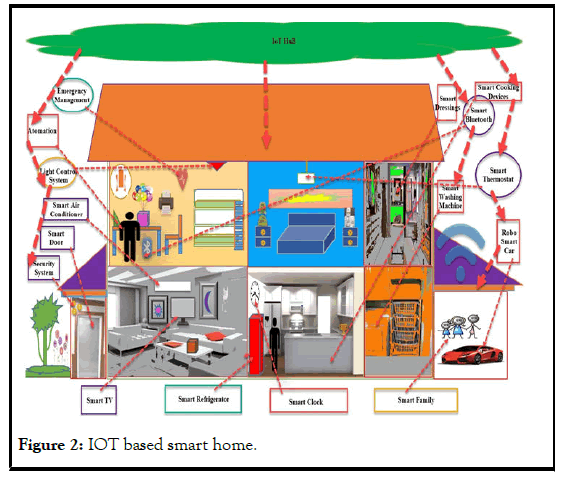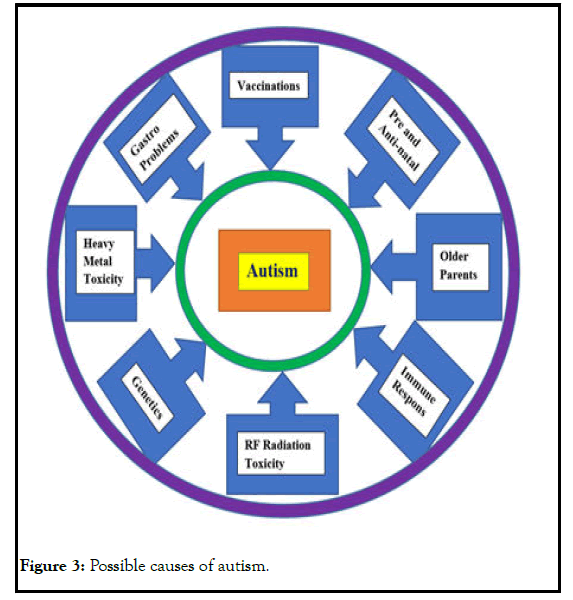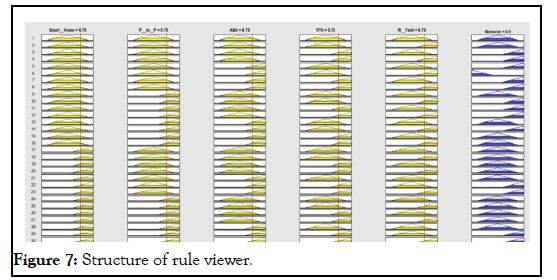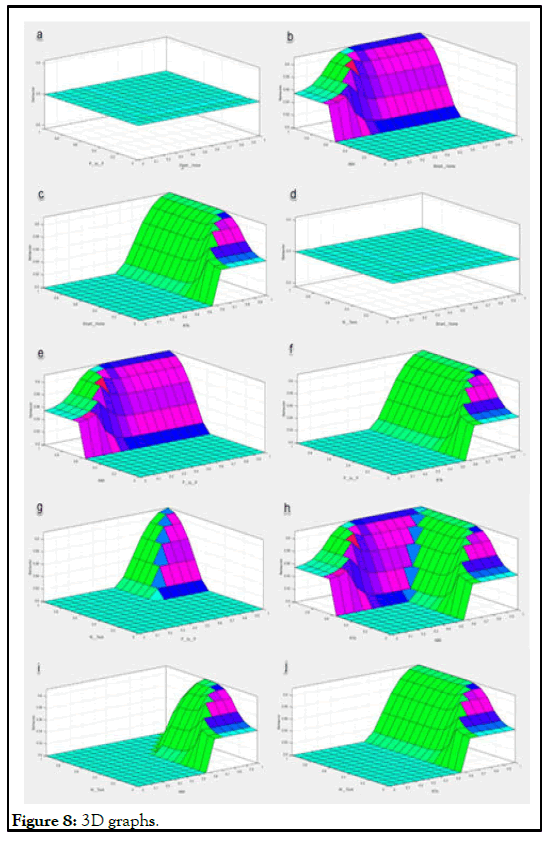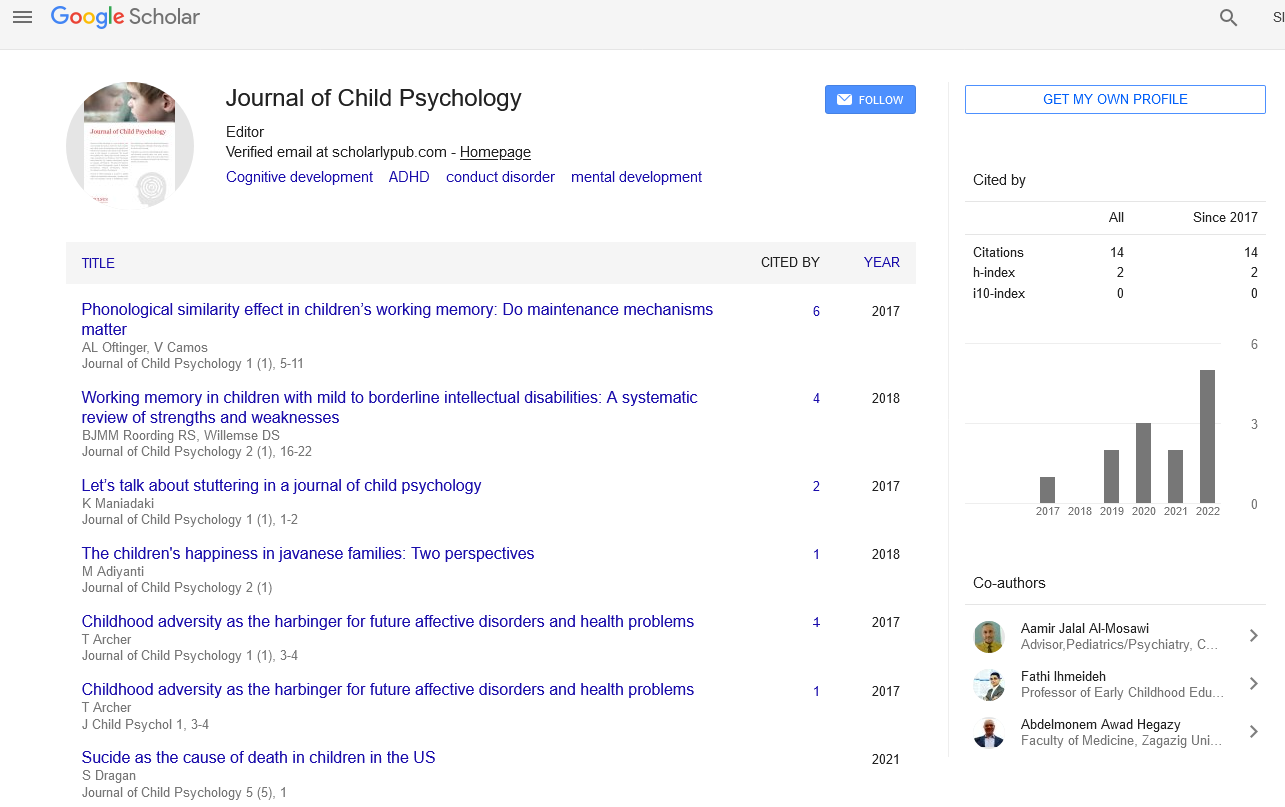Analysis and real time implementation of IOT in autism
2 Department of Physics, G.C. University, Lahore, Pakistan
3 Department of Computer Engineering, University of Lahore, Lahore, Pakistan
4 Department of Physics, Government APWA Graduate College, Lahore, Pakistan
Received: 27-May-2022, Manuscript No. PULJCP-23-5001; Editor assigned: 31-May-2022, Pre QC No. PULJCP-23-5001(PQ); Reviewed: 14-Jun-2022 QC No. PULJCP-23-5001; Revised: 02-Jan-2023, Manuscript No. PULJCP-23-5001(R); Published: 30-Jan-2023
Citation: Afzal MJ, Ashraf MW, Tayyaba S, et al. Analysis and real time implementation of IOT in autism. J Child Psychol. 2023;7(1):1-8.
This open-access article is distributed under the terms of the Creative Commons Attribution Non-Commercial License (CC BY-NC) (http://creativecommons.org/licenses/by-nc/4.0/), which permits reuse, distribution and reproduction of the article, provided that the original work is properly cited and the reuse is restricted to noncommercial purposes. For commercial reuse, contact reprints@pulsus.com
Abstract
The present study comprises the importance and use of IoT, smart home, peer to peer and some other different technologies for the betterment of mankind. Artificial intelligence and machine learning are becoming more and more popular in IoT based smart homes and other techs. The IoT framework has been used to provide a predictable, concrete and self-paced learning environment and encourages excellent visual information processing. These techs are also useful for special children in autism. They need smart homes, peer to peer networking, robot therapy and wearable techs.
In this paper, the authors presented a unique FLC simulation for the behavior of a child in moderate autism. This simulation shows that how IoT, smart home, peer to peer technology, ABA therapy, robot therapy and wearable techs can bring comforts in the life of child with autism. All of them have long lasted impacts in producing social skills in an ASD person. The 3D graphical figures presented the graphical analysis of child’s social behavior. Simulation presented 50% betterment change in the social behavior of children and this can be increased up to 87% by using intensive therapies. It is also verified by mamdani’s method. A real time implementation of a boy in autism has shown significant improvements in his social skills.
Keywords
Smart home; Autism; Wearable techs; Fuzzy logic
Introduction
Internet is an innovative invention of previous decades. It is continuously changing into some different types of interconnected software and hardware. It is a kind of interlinked communication either human to human or human to devices. Internet of things is a coordination of electronic system in which computing devices are interconnected and interrelated. All types of digital and mechanical articles and machines have capabilities to transfer information to interlinked networks. There is no requirement of interaction of humans in this system. Top eighteen IoT systems with devices are shown below in the following Figure 1.
The most important application of IoT is smart home. It is an internet connected house in which 24 hour remote monitoring, supervision and control of all electronic devices have been enabled. It is all about IoT. All home electronic devices can be organized and supervised by using internet. In recent times, IoT has progressed forward to monitor, control and supervised every device from fingertip movement and also with voice. This can command a device how to respond and work i.e., when it should turn on and off. Through this way one can set a schedule, set smart TV for videos and music, control of smart thermostats control time, money, convenience for benefits, produce alerts and notification on mobile whenever some unexpected event occurs. It is a tension free system in which one can get rid of failure of electricity, burning fire and water leakage. These can be the major alerts. It is actually the new group of smart phones and artificial intelligence. This technology can use Wi-Fi signals to increase its capacity. Through this technology, every light switch, each security system, electrical and electronical devices can communicate with each other. The system of a smart home generally works by the internet connected hub and can direct signals to every device for its operation and working. Even these devices can be controlled and supervised from millions of miles away from home with mobile phones and voice commands. In this way, precious time and money can be saved. Bed room temperature can be monitored from your office then actually you are fantasizing IoT based smart home. It can also provide a statistical data of using all devices and their electricity bills for payment. Smart home automation can acquire owner’s habits and behaviors to modify all settings. With IoT based smart homes locks and garage doors can be opened and closed on the wish of owners with just simple voice commands from anywhere. The smart cameras, smart motion sensors can also be applied in order to enhance the security. Kitchen appliances, make grocery shopping lists and create recipes for cooking, smart refrigerators and smart coffee makers, keep track of expiration dates, control of cooking devices, washing machines and dryers, sense of an voltage upsurge, sense of water failures and turn off the water tap in time and every other work related to a home are the most important works for a smart living. This dream can be fulfilled only with IoT based smart home. Artificial intelligence and machine learning are becoming more and more popular in IoT based smart homes [1].
Materials and Methods
The proper use of all these IoT based systems can make our life easy and help a child in autism. The modern therapies need these systems. These electronic systems are basically smart systems with internet connections. They are capable of interaction with the other devices and humans to exchange information. These systems can use latest technologies like wireless, bluetooth, NFC, LTE, zig-bee and wireless protocols. IoT is now linked in every therapy and the control system to monitor these kids. Mostly, children in autism have interest and get motivation by IoT devices like computer, tablets, laptops and wearable devices. With these devices, kids get some social interaction. They can respond, make choice and communicate with others. They can tell their parents, siblings and teachers what they want to eat their desire, feel, need and maybe even think.
Embedded devices have got fresh advancements in data collection. They can control large number of smart devices. These devices allow parents to monitor their kids in autism and also in other areas like home electronics and security systems. As these devices become more common, the need will increase for a home networking strategy that will allow all data, voice and smart devices to be accessed at anytime from anywhere. There are some technical software, frameworks and systems for help in autism which are discussed below. A smart home has shown below in the following Figure 2.
Autism is a brain disorder and it shows in spectrum disorder. Kids have these symptoms by birth. These indications present in wide spread combinations in spectrum from mild to severe. Kids having autism have difficulties in communications, interactions and relations. This can compel a child to repeat his or her activities again and again. These children become easily upset when their daily routine changes. They react unusually with strange responses in many conditions. The symptoms of autism can be seen within one year of birth. Babies are not achieving their major milestones after birth like babbling, major motor skills, behavior and less smiling. There are many others milestones which are not achievable by these kids. Babies with ASD may be very sensitive to some feelings like touch, smells, some noises, temperature differences and also with some colors.
These kids may develop usual language and social skills but regressive autism takes their skills away in no time. In many cases, they have not developed their languages. They are not just tune into active kids with cognitive abilities. It does not mean that these kids don’t have any abilities. They have abilities, all we have to demonstrate and unleash their abilities out of them and improve their capabilities. Parents believe that childhood vaccines are the reason of developing autism and otherwise. There are many theories “causation of autism” exist but no medically proven theory exist [2]. The possible causes of autism are genetics, vaccines, abnormal neural development, mercury preservatives, environment, bad parenting and traumatic experiences in kids. The use of cellphones, two way radios, portable telephones and wireless devices near new born babies can be the cause of autism. It means electromagnetic radiation can have roots in producing autism. Brain autopsy has shown deficits in numerous portions of brain. These can be shown in the following Figure 3.
Research has not shown any scientific confirmation which supports any type of linkage between vaccinations and autism. Therefore parents should take care of childhood vaccines as in other normal kids to avoid any other dangerous illness. Researchers indicated that genetic factors can be the cause and they predominated. Autism is complex and it is difficult to say that which genes are the actual causes.
There are some cases in which autism is linked with factors that can cause birth defects. There is no cure for autism but some hope is here for these kids. The continual of different types of therapies, pharma and IoT systems can help these kids for an independent, dynamic and prosperous life. Here in this research, IoT systems for the treatment and better use in therapies are focused.
Peer to Peer (P2P) computing or networking
A framework P2P communication amongst kids their parents and therapists are very effective now a days in autism. It is architecture of distribution of applications in which that all works and tasks is distributed amongst all peers. In this framework, every peer has equivalent advantage and can participate in all applications equally.
This complete system is said to form a peer to peer network of nodes. This framework has been used to provide a predictable, concrete and self-paced learning environment and encourages excellent visual information processing. It can analyze the behavior of the kids with autism. It can store all the data and then therapists can use them for the betterment of child. This can be shown in the following Figure 4.
There are always challenges for kids with autism. Autism is a source of unease, nervousness and anxiety for kids and as well as for parents. This technology helps these kids to understand friendship, to understand scripts, characters, images and visuals, to present real world rehearsal and practice, to build comforts and interests of these kids and to think long term achievements successfully. A newer system for supporting ASD children based on IoT and P2P technology have been introduced. This system uses JXTA overlay platform and smart box device to monitor the children and create P2P communication between children, caregivers and therapists. This system has been implemented on medical support system using P2P and IoT technologies. IoT systems can provide programmed monitoring framework by using sensors and IoT devices, for children with autism. These systems keep track of all data gathered by sensor readings. The data has been obtained from the brain signals of ASD kids. The analysis is performed on the basis of collected data and a report is generated for the therapists. IoT based health monitoring systems for ASD patients have been worked efficiently. This health monitoring system can be applied as a real time observation for vital health parameters of ASD children. Audi track is one of the IoT based monitoring framework for ASD children.
Results and Discussion
Applied Behavior Analysis (ABA)
It is a scientific and systematic methodology to understand the behavior of children with autism. ABA necessitates the implementation of well-known and recognized learning principles, behavior stratagems with environmental adaptations for the improvement the present behaviors and to teach new future behaviors. This tool was designed for a complete team to help kids with autism. Numerous members of ABA team must be involved to make this methodology perfect to the needs of these children. This therapy helps to improve new skills and abilities, to shape and refine previously learned skills and decrease socially significant problem behaviors. Applied Behavior Analysis (ABA) therapy is an important tool used in autism. It is a type of intensive therapy that focuses on the principles and techniques of learning theory to help and improvement in the social behavior of the child. This therapy helps them in developing new skills, in shaping and refining their previously learned skills and in decreasing their behavior problems socially [3].
Use of IoT based robots in autism
Robots can be used in autism as a new therapy tool for children. It is one of the most promising area in which robots have been introduced for ASD children. Robots have proven their importance in engagement and producing new social behaviors in teenagers and children with autism in novel scientific research. The use of robots in robot therapy is called Socially Assistive Robotics (SAR). SAR can develop robots to comfort people with autism through social interactions.
Wearable IoT based tech help in autism
In order to manage anxiety, people with autism need wearable devices. These devices have proved their authenticity in autism, they are game changer. A pair of bracelet, watch, google glasses, necklace, shoelaces, reveal and GPS tracking system can confirm the safety of ASD children. ASD children have a natural difficulty in noticing a danger, in understanding someone’s expression and in judging someone’s thinking and feelings precisely. An ASD child can be inspired to escape from a situation that can overstimulates him or her by moving to a safe place in their schools and homes on their own. An IoT based tracking tech can make this possible. Due to this the location of child can be monitored if they have moved elsewhere. The software of face recognition has been used in these glasses with a front cam. This tech can sense facial cues of a stranger and interpret them in the right or left corner of these glasses. ASD kids can see happy and sad emotions through these glasses. Therefore, they can develop social skills to recognize strangers. Reveal is an advanced wearable tech with simple bracelet design. It can sense emotional instants and translate them into useful information. It can sense heart rate, sweat levels, body temperature and other parameters. This data can transmit to further connected smart devices. In this way, parents can observe the stress levels of their child. ASD melt down issues can grow fast without any reason. It is very hard for parents to identify the real reason of melt downs. These traumatizing meltdowns can be due to their environment, mind, overstimulation and interactions. Reveal can track the precise times when they felt most stress. In this way, they can reverse engineer this fact with the help of reveal to determine the exact reason of a meltdown and avoiding it in future [4].
Fuzzy logic parametric estimation
Consider a Fuzzy Logic Controller for therapies in moderate autism (FLC Autism). This controller has five inputs with one output. The inputs are smart home, Peer to Peer (P to P), ABA therapy (ABA), Robot Therapy (RTh) and Wearable Techs (WTech) with behavior of child as an output. Inputs have three membership functions and output has also three membership functions for decision making [5]. Fuzzy Logic technique is a very innovative technique and lot researchers have used this tool in IoT and other fields. The controller is shown in the following Figure 5.
The rules for this simulation was set according to the IF and THEN statement. The rule viewer is shown in Figure 6.
The rule viewer diagram is shown below in which all values are set at 75%. The output is then simulated at 50%. It means every 75% input value we can get only 50% output [6]. The value of output can be increased up to 87% when the values of all inputs must be increased up to 100% (Figure 7).
The fuzzy logic matlab simulated 3D graphs have been shown in the following Figure 8.
The 3D graph “a” has shown only a maximum of 50% betterment can be achieved in the behavior of a child in moderate autism, if only two inputs (P to P and smart home) are analyzed. These graphs shows even and smooth contributions of these two inputs. It also depends upon the rate of severity of autism. Here is only moderate autism is considered. In severe autism it would be very much below 50%. Here, the 3D graph “b” has shown more than 60% betterment can be achieved in the behavior of a child in moderate autism, if only two inputs (ABA and smart home) are analyzed. This graph shows continuous efforts given to the child with these two inputs. The slope of the graph shows the fast changes in the behavior, once child is used to it. It also depends upon the rate of severity of autism. Here is only moderate autism is considered. In severe autism it would be very much below 50%. Here, the 3D graph “c” has shown more than 60% betterment can be achieved in the behavior of a child in moderate autism, if only two inputs (RTh and smart home) are analyzed. This graph shows continuous efforts given to the child with these two inputs. The slope of the graph shows the fast changes in the behavior, once child is used to it. It also depends upon the rate of severity of autism. Here is only moderate autism is considered. In severe autism it would be very much below 50%. The 3D “d” graph has shown only a maximum of 50% betterment can be achieved in the behavior of a child in moderate autism, if only two inputs (WTech and smart home) are analyzed. These graphs shows even and smooth contributions of these two inputs. It also depends upon the rate of severity of autism. Here is only moderate autism is considered. In severe autism it would be very much below 50%. Here, the 3D graph “e” has shown more than 60% betterment can be achieved in the behavior of a child in moderate autism, if only two inputs (ABA and P to P) are analyzed. This graph shows continuous efforts given to the child with these two inputs. The slope of the graph shows the fast changes in the behavior, once child is used to it. It also depends upon the rate of severity of autism. Here is only moderate autism is considered. In severe autism it would be very much below 50%. Here, the 3D graph “f” has shown more than 60% betterment can be achieved in the behavior of a child in moderate autism, if only two inputs (P to P and RTh) are analyzed. This graph shows continuous efforts given to the child with these two inputs. The slope of the graph shows the fast changes in the behavior, once child is used to it. It also depends upon the rate of severity of autism. Here is only moderate autism is considered. In severe autism it would be very much below 50%. Here, the 3D graph “g” has shown more than 60% betterment can be achieved in the behavior of a child in moderate autism, if only two inputs (WTech and P to P) are analyzed. This graph shows continuous efforts given to the child with these two inputs. The slope of the graph shows the fast changes in the behavior, once child is used to it. It also depends upon the rate of severity of autism. Here is only moderate autism is considered. In severe autism it would be very much below 50%. Here, the 3D graph “h” has shown more than 60% betterment can be achieved in the behavior of a child in moderate autism, if only two inputs (ABA and RTh) are analyzed. This graph shows continuous efforts given to the child with these two inputs [7]. The slope of the graph shows the fast changes in the behavior, once child is used to it. It also depends upon the rate of severity of autism. Here is only moderate autism is considered. In severe autism it would be very much below 50%. Here, the 3D graph “i” has shown more than 60% betterment can be achieved in the behavior of a child in moderate autism, if only two inputs (ABA and WTech) are analyzed. This graph shows continuous efforts given to the child with these two inputs. The slope of the graph shows the fast changes in the behavior, once child is used to it. It also depends upon the rate of severity of autism. Here is only moderate autism is considered. In severe autism it would be very much below 50%. Here, the 3D graph “j” has shown more than 60% betterment can be achieved in the behavior of a child in moderate autism, if only two inputs (WTech and RTh) are analyzed. This graph shows continuous efforts given to the child with these two inputs. The slope of the graph shows the fast changes in the behavior, once child is used to it. It also depends upon the rate of severity of autism. Here is only moderate autism is considered. In severe autism it would be very much below from 50% [8-10].
Verification through mamdani’s principal
The simulated value was verified through mamdani’s principal. Selected inputs and obtained output parametric values are used to design FLC Autism system. All the regions of MFs graph are plotted in the Figure 9.
The inputs are smart home, P to P, ABA, RTh and WTech and their ranges are taken as (0, 0.5, 1). Mf1 is taken as small (0, 0, 0.5). Mf2 is taken as medium (0, 0.5, 1). Mf3 is taken as large (0.5, 1, 1). All values of F’s are calculated by mamdani’s method [11-14].
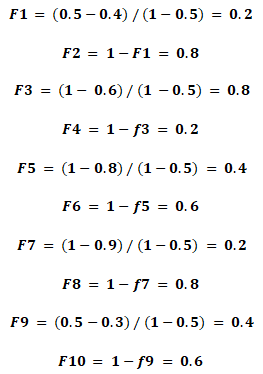
Therefore, the singleton value for output behavior is taken as for minimum is 0, for middle is 0.05 and for high is 0.01. The values of all F’s with their levels and all calculations through mamdani’s method are compiled in Tables 1 and 2.
| F1 | F2 | F3 | F4 | F5 | F6 | F7 | F8 | F9 | F10 |
|---|---|---|---|---|---|---|---|---|---|
| 0.2 | 0.8 | 0.8 | 0.2 | 0.4 | 0.6 | 0.2 | 0.8 | 0.4 | 0.6 |
| Low | Medium | Low | Medium | Medium | High | Medium | High | Low | Medium |
Table 1: All values of F’s.
| No. | Minimum membership function value | Behavior | Min value Ri | Singleton Si | ΣRiSi | ||||
|---|---|---|---|---|---|---|---|---|---|
| 1 | 0.2 | 0.8 | 0.4 | 0.2 | 0.4 | Small | 0.2 | 0 | 0 |
| 2 | 0.2 | 0.2 | 0.6 | 0.8 | 0.6 | Small | 0.2 | 0 | 0 |
| 3 | 0.2 | 0.8 | 0.4 | 0.8 | 0.6 | Medium | 0.2 | 0.005 | 0.01 |
| 4 | 0.2 | 0.8 | 0.6 | 0.2 | 0.4 | Small | 0.2 | 0 | 0 |
| 5 | 0.2 | 0.2 | 0.4 | 0.2 | 0.4 | Small | 0.2 | 0 | 0 |
| 6 | 0.2 | 0.8 | 0.6 | 0.8 | 0.6 | Small | 0.2 | 0 | 0 |
| 7 | 0.2 | 0.2 | 0.4 | 0.8 | 0.6 | Small | 0.2 | 0 | 0 |
| 8 | 0.2 | 0.2 | 0.6 | 0.2 | 0.4 | Small | 0.2 | 0 | 0 |
| 9 | 0.8 | 0.8 | 0.4 | 0.2 | 0.4 | Small | 0.2 | 0 | 0 |
| 10 | 0.8 | 0.2 | 0.6 | 0.8 | 0.6 | Small | 0.2 | 0 | 0 |
| 11 | 0.8 | 0.8 | 0.4 | 0.8 | 0.6 | Small | 0.4 | 0 | 0 |
| 12 | 0.8 | 0.8 | 0.6 | 0.2 | 0.4 | Small | 0.2 | 0 | 0 |
| 13 | 0.8 | 0.2 | 0.4 | 0.2 | 0.4 | Small | 0.2 | 0 | 0 |
| 14 | 0.8 | 0.8 | 0.6 | 0.8 | 0.6 | Small | 0.6 | 0 | 0 |
| 15 | 0.8 | 0.2 | 0.4 | 0.8 | 0.6 | Medium | 0.2 | 0.005 | 0.01 |
| 16 | 0.8 | 0.2 | 0.6 | 0.2 | 0.4 | Small | 0.2 | 0 | 0 |
| Total | 3.8 | 0.2 | |||||||
Table 2: Mamdani’s principal calculations.
The value calculated with the help of equation of mamdani’s principal is given below:

The results have been evaluated and shown in Table 3 below.
| Category | Behavior |
|---|---|
| Fuzzy logic value | 0.5 |
| Mamdani’s value | 0.52 |
| Difference | 0.02 |
Table 3: Result evaluation.
Table 3 shows that simulated value is verified by mamdani’s principal. This study is limited to just these five inputs and output with only moderate autism. These children in autism also show some type of regression in output. They also can have three levels of autism. These are mild, moderate and severe autism. In this article the regression and mild and severe levels of autism has ignored. The authors will study them in future [15,16].
Real time implementation
New technologies have been introduces in the beginning of 21st century to support ASD persons in everyday life and leisure. Children with autism often have problems in communication with their peers, grown-ups, teachers and parents. In this study, the authors presented an innovative fuzzy logic simulation to improve the social skills in children with ASD. These children are observed while playing or using their tablets or laptops while the parents, teachers and therapists track the child's behavior with IoT, peer to peer system, smart homes and robot therapies [17,18]. The real time implementation of this study on a twelve year old boy with autism is shown below. This study is carried over six month’s period. The improved skills are broken down in a Table 4.
| No. | Title | Remarks (before six months) | Remarks (after six months training using IoT devices) | Tool used |
|---|---|---|---|---|
| 1. | Reinforcement efficiency | Least response | Responding well to inspiration and motivation | IoT |
| 2. | Pictorial performance | Minimum response | The capability to understand things pictorially is much improved | ABA |
| 3. | Language | Medium response | The capability to understand verbal languages is much improved | IoT |
| 4. | Vocal and motor imitation | Fewer words in vocabulary | The capability of imitate the actions of others and the sounds and words which others make is much improved | IoT and ABA |
| 5. | Requirements | Least response | The capability in demanding things with request is much improved | ABA |
| 6. | Labeling things | Needs to be improved | The capability of labeling things or their features and purposes is much improved | ABA |
| 7. | Verbal behavior | The intraverbals of objects are not present before | The capability of responding to simple stimulus words is much improved | IoT |
| 8. | Vocalizations | Less vocalized | The capability of using language without being encouraged is much improved | IoT and ABA |
| 9. | Grammar and composition | Minimum speech | The capability of putting words and sentences together is improved | ABA |
| 10. | Playing and leisure | Self-playing | The capability of solitary and group playing skills are improved a bit | RTh and smart home |
| 11. | Social communication | None | Capabilities concerning communication with peers and grown-ups are improved | ABA |
| 12. | Group coaching | None | Capability of learning in groups is improved | ABA |
| 13. | Classroom habits | Fewer | Aptitude in following school rules and common routines are much improved | ABA |
| 14. | General response | None | The capabilities to generalize material learned and use it in real life or novel situations are much improved | ABA and peer to peer with IoT |
| 15. | Reading evaluation | Better in alphabets | The ability of reading sentences are much improved | Smart tablet and ABA |
| 16. | Mathematics | Medium level | The ability of recognizing numbers, their counting, less, greater and equal, basic type of addition and subtraction are improved | IoT, ABA, Rth and Smart Calculator |
| 17. | Writing analysis | Medium level | The ability of copying, writing on papers, copies and on boards improved | IoT, ABA and Rth |
| 18. | Spelling of words | None | Spelling learning ability is much improved | IoT and ABA |
| 19. | Dressing habits | None | Capability of dressing and undressing with self-independence is improved | Smart tablet and ABA |
| 20. | Eating habits | Messy | Simple basic self-help abilities regarding eating and preparing of food is much improved | IoT, ABA and Rth |
| 21. | Grooming | Messy | The ability of controlling the basic self-help skills regarding grooming and hygiene is improved | Peer to peer, ABA and smart home |
| 22. | Toilet use | Basic | The capability of self-help skills regarding toileting is improved | Smart tablet and Rth |
| 23. | Gross motor skills | Basic | Large motor activities such as: Ball playing, swaying, swinging, running, skipping, hopping are improved | IoT, ABA, Rth and smart tools |
| 24. | Fine motor skills | Basic | Fine motor activities such as: Writing, turn pages of copy or book, cutting papers, pasting on papers are much improved | IoT, ABA, Rth and smart tools |
| 25. | Facial recognition | Fewer | The ability of recognition different faces is improved | IoT, ABA and smart tools |
| 26. | Quran learning | Fewer | He can recite many Surah’s like Ar-Rehman, Al-Fajar, Wazuha etc. | IoT, ABA and smart Tv |
Table 4: Improved skills with tool used.
Fuzzy and real time analysis of ASD children has significant importance in fields like motor skills, learning, dressing, verbal, non-verbal expression, human computer interaction and other interactions. In this study, the authors presented an assistive system designed for ASD children for improving their social skills and behavior. The system is built up of IoT devices and different new technologies and therapies. The system requires active participation of a teachers, therapists and parent. They can select skills to learn with analysis of behavior. The complete process is planned to extend parent’s care and to support ASD children. In both real time and simulated area, the boy with autism made a visible progress in enhancing his social behavior [19].
Conclusion
Internet of Things (IoT) device is a burning topic in the current era. It is understood how these smart devices developed by mankind for mankind are impacting in both positive and negative ways. For the betterment of a child with autism IoT, smart home, peer to peer technology, ABA therapy, robot therapy and wearable techs can bring comfort in the life of an ASD child, teenager and an adult. All of them have long lasted impacts in producing social skills in an ASD person. 3D graphs have shown different percentages of betterment in behavior. Accumulative change in behavior with all these five inputs (75% therapies) is just 50% which can be increased up to 87% with 100% intensive therapies. It is also verified by mamdani’s method. The question is whether every child with autism can bear 100% intensive therapies or not. Usually these children can’t bear intensive therapies. Therefore, 75% therapies are considered in this manuscript. Fuzzy logic can be used for making decision for the betterment in behavior percentage. Fuzzy logic describes membership functions to take perfect decision. Real time implementation of a boy in autism has shown significant changes in his social behavior.
Conflict of Interest
The authors declare no conflict.
References
- Lee I, Lee K. The Internet of Things (IoT): Applications, investments and challenges for enterprises. Bus Horiz. 2015;58(4):431-40.
- Alam MR, Reaz MB, Ali MA. A review of smart homes past, present and future. Appl Rev. 2012;42(6):1190-203.
- Qashlan A, Nanda P, He X. Automated ethereum smart contract for block chain based smart home security. In smart systems and IoT: Innovations in computing: Proceeding of SSIC 2019-2020, Singapore, 2017, pp. 313-26. Springer Singapore.
- Singh G, Swarnkar A, Gupta N, et al. A review of scheduling techniques and communication protocols for smart homes capable of implementing demand response. Energies. 2020:505-13.
- Kyriakopoulos G, Ntanos S, Anagnostopoulos T, et al. Internet of Things (IoT) enabled elderly fall verification, exploiting temporal inference models in smart homes. Int J Environ Res. 2020;17(2):408.
- Machorro-Cano I, Alor-Hernandez G, Paredes-Valverde MA, et al. HEMS-IoT: A big data and machine learning based smart home system for energy saving. Energies. 2020;13(5):1097.
- Cheruvu S, Kumar A, Smith N, et al. Demystifying internet of things security. 2021;(5):312-13
- Lord C, Rutter M, DiLavore PC. Autism diagnostic observation schedule generic. Diss Abstr Int. 1999.
- Trottier G, Srivastava L, Walker CD. Etiology of infantile autism: A review of recent advances in genetic and neurobiological research. J Psychiatry Neurosci. 1999;24(2):103.
- Thornton IM. Out of time: A possible link between mirror neurons, autism and electromagnetic radiation. Med Hypotheses. 2006;67(2):378-82.
- Kane RC. A possible association between fetal/neonatal exposure to radiofrequency electromagnetic radiation and the increased incidence of Autism Spectrum Disorders (ASD). Med Hypotheses. 2004;62(2):195-7.
- Doja A, Roberts W. Immunizations and autism: A review of the literature. Can J Neurol Sci. 2006;33(4):341-6.
- Freitag CM. The genetics of autistic disorders and its clinical relevance: A review of the literature. Mol Psychiatry. 2007;12(1):2-2.
- Arndt TL, Stodgell CJ, Rodier PM. The teratology of autism. Int J Dev Neurosci. 2005;23(2-3):189-99.
- Sula A, Spaho E, Matsuo K, et al. A new system for supporting children with autism spectrum disorder based on IoT and P2P technology. Int J Soft Comput. 2014;4(1):55-64.
- Gawannavar M, Jeyanthi N, Thandeeswaran R. AutiTRACK: Monitoring autism patients with IoT. Int J Telemed Appl Prac. 2016;1(4):314-22.
- Artoni S, Claudia Buzzi M, Buzzi M, et al. A portable application for supporting ABA intervention. J Assist Technol. 2013;7(2):78-92.
- Scassellati B, Admoni H, Mataric M. Robots for use in autism research. Annu Rev Biomed Eng. 2012;14:275-94.
- Ramirez-Duque AA, Aycardi LF, Villa A, et al. Collaborative and inclusive process with the autism community: A case study in Colombia about social robot design. Int J Soc Robot. 2021;13:153-67.





